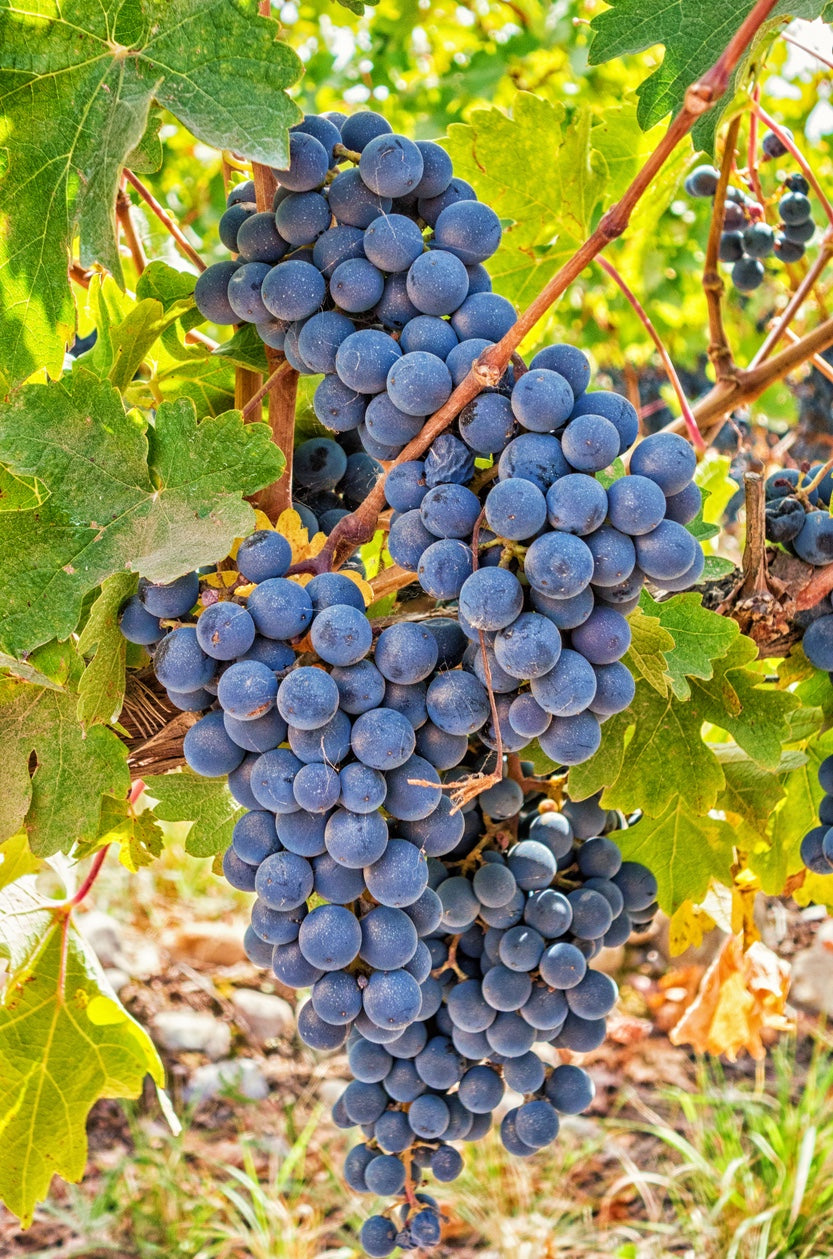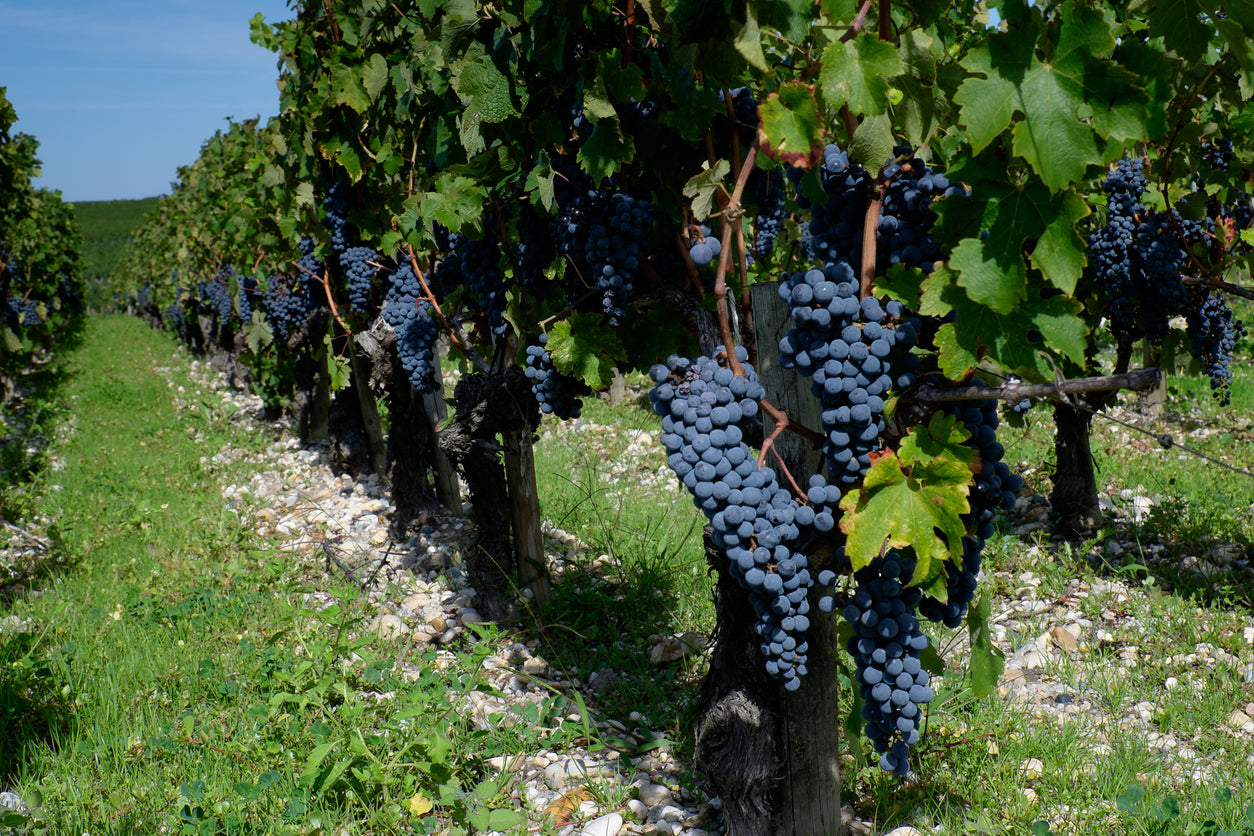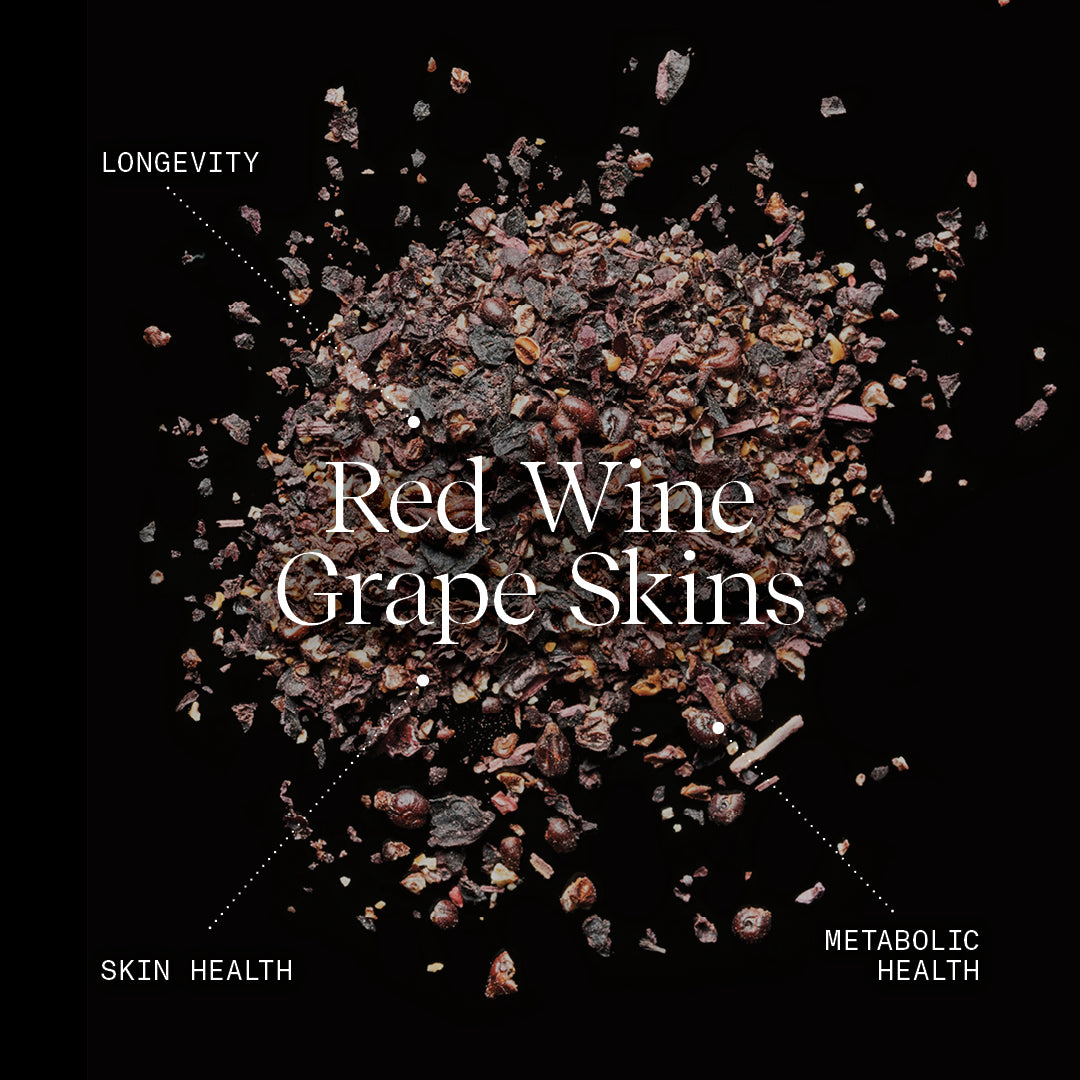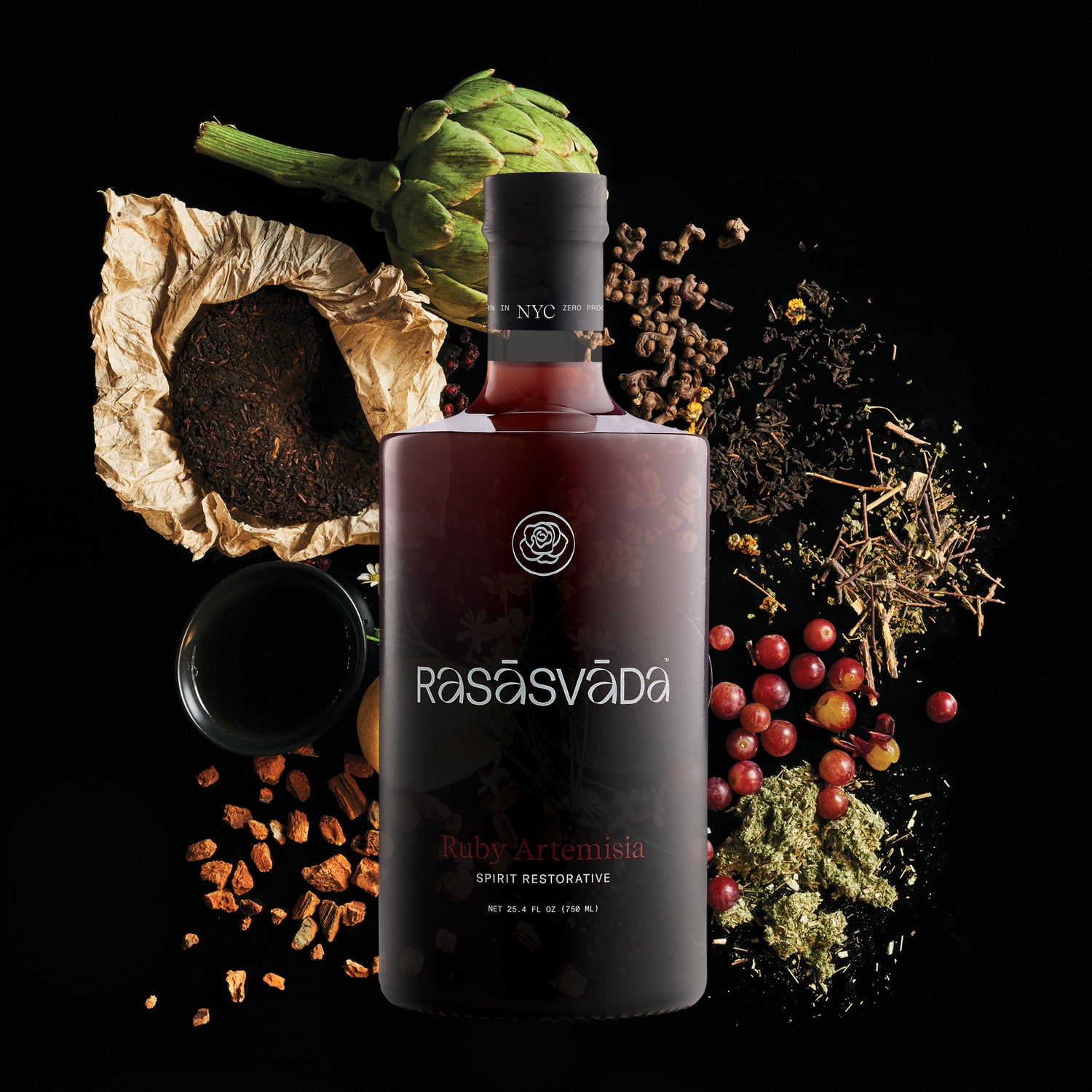Red wine and their grapes have long been debated for their role in heart health, but the functional wellness benefits are found in the skins. With a concentration of antioxidants, grape skins have potent compounds of resveratrol and anthocyanins, which can support heart health, longevity, and resilience at the cellular level.
Botanical Overview

- Botanical Name: Vitis vinifera (common grapevine)
- Family: Vitaceae
- Common Names: Red grape, wine grape, European grape, Pútáo (葡萄 in TCM), Draksha (Ayurveda), Angoor (Persian/Unani), and Enocianina (in Europe, referring to anthocyanin extract)
- Phytochemical Highlights:
- Resveratrol – a polyphenol studied for cardiovascular support and longevity
- Quercetin – an anti-inflammatory flavonoid with immune benefits
- Anthocyanins – pigment compounds responsible for red-purple color and strong antioxidant effects
- Tannins – astringent compounds that support circulation, digestion, and skin health
What is a Wine Grape?
A wine grape is a variety of grape (Vitis vinifera) cultivated not only for winemaking but also valued in traditional medicine for its nutrient-rich skins. Compared to table grapes, wine grapes are smaller, have thicker skins, contain seeds, and are much sweeter, with a higher sugar content that makes them ideal for fermentation. They’re also richer in antioxidants—especially resveratrol and anthocyanins—concentrated in the skins, which give red wines (and grape-skin extracts) their color, tannins, and many of their health benefits.
History & Traditional Uses
From the vineyards of ancient Mesopotamia to the banquets of Greece and Rome, grapes have been revered for over 6,000 years. They were a sacred fruit in ritual, diet, and medicine, symbolizing abundance and vitality. While wine became the most famous expression of grapes, traditional healers also prized the skins, rich in pigments and bitterness, for supporting inflammation, digestion, and cardiovascular health.
In Traditional Chinese Medicine (TCM), grapes are considered sweet and neutral, nourishing Qi, blood, and fluids. Modern TCM formulas often integrate grape skins specifically for circulation, antioxidant richness, and longevity support. Ayurvedic and Persian medicine likewise classified grapes as cooling, nourishing, and heart-protective.

The Health Benefits of Red Wine Grape Skins
1. Antioxidant & Anti-Inflammatory Support
Red wine grape skins are rich in polyphenols and flavonoids which are plant compounds that act as powerful antioxidants. Key among these are resveratrol, quercetin, and anthocyanins, which help neutralize free radicals (unstable molecules that can damage cells and accelerate aging). By doing this, grape skins help protect DNA, lipids, and proteins in the body, laying the foundation for long-term vitality. In addition to fighting oxidation, these compounds play a direct role in reducing inflammation and support the body’s natural anti-aging and defense systems.
Traditional Chinese Medicine (TCM) mirrors this perspective: grape skins’ “cooling” nature is said to clear heat and calm inflammation, particularly in the blood and liver. Western research gives this ancient wisdom a modern foundation, linking the deep pigments and bitter compounds in grape skins with measurable antioxidant and anti-inflammatory effects.
2. Cardiovascular Support
Traditional Chinese Medicine (TCM) describes grapes as nourishing to Qi and blood, and Western medicine echoes these findings in red wine grape skins’ role in supporting heart and vascular health. Much of this is credited to the antioxidants concentrated in the skins. They’re said to help raise HDL (“good” cholesterol) and reduce LDL (“bad” cholesterol), a key step in protecting the heart.
Grape-skin compounds also support healthy blood pressure by improving endothelial function, the ability of blood vessels to relax and expand (also called “vascular flexibility”). This promotes better circulation and reduces strain on the cardiovascular system, strengthening capillaries and supporting smooth blood flow.
These benefits tie into the “French Paradox,” where red wine (rich in grape-skin compounds) has been associated with heart health and longevity despite high-fat diets. Rasāsvāda’s Ruby Artemisia lets you enjoy the benefits of red wine grape skins without the presence of alcohol.
3. Immune Support
Polyphenols and flavonoids in red wine grape skins may support the body’s immune response by playing a role in reducing inflammation. Scientists think resveratrol could be key to preventing certain diseases but current studies have mixed conclusions and more research – with results applicable to humans – is needed.
- Quercetin, a key compound in grape skins, is noted for its antiviral potential and its ability to influence inflammation.
- Anthocyanins, the pigments responsible for the skins’ deep color, have also been linked to improved defense against oxidative stress in immune cells, helping reduce the risk of chronic inflammation. In Traditional Chinese Medicine (TCM), grapes are considered nourishing to Qi and fluids, which strengthens the body’s resilience. This perspective aligns closely with modern findings: the antioxidant and anti-inflammatory compounds in grape skins give the immune system both balance and strength.
4. Metabolic Health
Red wine grape skins may also play a role in supporting healthy metabolism, particularly in how the body manages blood sugar and fats. The in-skin compounds may help balance blood sugar and lipid metabolism, potentially supporting healthy weight management and metabolic efficiency.
Resveratrol has been shown to improve insulin sensitivity, which may mean that cells use glucose more efficiently, reducing blood sugar spikes. Plus, anthocyanins and quercetin support metabolic and cardiovascular health by reducing cholesterol and triglyceride levels, according to animal studies.
In Traditional Chinese Medicine (TCM), grapes are thought to replenish Qi and fluids, which parallels the modern understanding of grape skins as supportive for energy balance and circulation. Together, these compounds make grape skins a natural ally for maintaining steady energy, supporting digestion, and promoting overall metabolic efficiency.
5. Brain & Longevity Benefits
Research continues to explore how resveratrol and anthocyanins support cognitive function and healthy aging. Because of the antioxidant activity, scientists are discovering how resveratrol can protect the brain. More research is needed, but given the host of other benefits, studies are now monitoring how this powerful antioxidant can help with macular degeneration, stroke, and dementia.
6. Skin Health
You may have seen many beauty products touting the ingredient resveratrol, and rightfully so: antioxidants from grape skins help protect against oxidative damage, supporting clearer, more resilient skin. Applied topically, red wine tannins may combat signs of aging and fine lines.

Red Wine Grape Skins in Rasāsvāda

Rasāsvāda has harnessed the power of grape skins in Ruby Artemisia, a restorative drink layered with schisandra berry, maqui berries, ume plums, and bitters. The grape skins bring both concentrated antioxidants and functional bitterness, offering depth, tannic complexity, and earthy fruitiness.
- Flavor Profile: Deep, tannic, slightly astringent, with rich earthy fruit tones that balance and ground the blend.
- Sourced from: Alsace, France
Key Takeaways
Red wine grape skins are far more than a byproduct of winemaking—they are a concentrated source of antioxidants. From their role in TCM to their modern recognition for supporting heart health, longevity, and vitality, grape skins bridge both history and science. In Rasāsvāda, they offer both functional benefits and a bold, layered taste that elevates your wellness rituals.
FAQs
Disclaimer
While red wine grape skins are generally considered safe for most people, those who are pregnant, breastfeeding, have allergies to grapes, or are taking medications such as blood thinners should consult a qualified healthcare provider before use. Dietary supplements and herbal ingredients are not regulated by the FDA in the same way as prescription drugs, so always seek professional guidance when adding new botanicals to your wellness routine.
100% plants. 0% preservatives.
Sources
Bioactive Compounds, Health Benefits and Food Applications of Grape - PMC
Ben Cao Gang Mu, Volume IX by Li Shizhen - Hardcover - University of California Press
Draksha: An Ayurvedic Perspective on Grapes — Alandi Ayurveda
The Grape Antioxidant Resveratrol for Skin Disorders: Promise, Prospects, and Challenges - PMC
The Immunomodulatory and Anti-Inflammatory Role of Polyphenols - PMC
Insights into the Anti-inflammatory and Antiviral Mechanisms of Resveratrol - PMC
Resveratrol and Vascular Function - PubMed
Influence of Resveratrol on the Immune Response - PMC
Chinese Nutrition Properties of Grape
Resveratrol Counteracts Insulin Resistance—Potential Role of the Circulation - PMC
Resveratrol and cognitive decline: a clinician perspective - PMC
The French paradox three decades later: Role of inflammation and thrombosis - ScienceDirect
